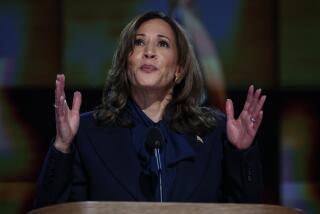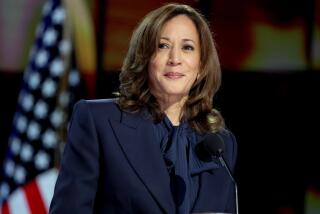As Candidate, Bradley Was Too Left to Be Mr. Right for Democratic Party
What if they gave a counterrevolution and nobody came?
Ever since Bill Clinton emerged in 1992, a noisy portion of the Democratic left in Congress and key constituency groups has been itching to reverse the centrist “New Democratic” course he set for the party. But when Bill Bradley, however imperfectly, tried to inspire such a liberal revolt against Al Gore this year, it turned out that he had almost no one behind him except firebrand Sen. Paul Wellstone of Minnesota and the editors of the Nation and the American Prospect. Precious few voters followed, as Gore romped to the nomination.
“Bradley ended up being the New Deal liberal Democrat attacking the New Democrats, and that just did not really resonate with many voters,” says pollster Mark Baldassare, a senior fellow at the nonpartisan Public Policy Institute of California. “I think it suggests the Democratic Party has changed in some fundamental way, and has really adopted the New Democratic strategy.”
Leftist critics of Clinton and Gore correctly quibble that Bradley was an unlikely champion for their cause. A solitary senator who rarely enlisted in causes not of his own design, Bradley lacked personal ties with left-leaning groups (such as organized labor) that might have generated more enthusiasm for his candidacy. And Bradley couldn’t tap into the protectionist sentiments on the left--one of the most powerful sources of opposition to Clintonism--because he, like Gore, supports free trade.
But on almost every other major issue where he differed with the vice president, Bradley moved to Gore’s left. Indeed, Bradley offered as the overarching rationale for his candidacy the core liberal complaint that Clinton and Gore, in their eagerness to reassure centrist voters, have been reduced to nibbling around the edges of problems “with rhetorical flourishes followed by tiny, demonstration projects.” Democrats, Bradley insisted, needed “big ideas.”
As it turned out, those ideas almost all reflected priorities that liberals felt Clinton had slighted. Bradley made the centerpiece of his campaign a plan to provide health care for the uninsured that would have constituted the most expensive domestic spending initiative in decades. He called for registering all handguns (and ridiculed Gore as timid when he suggested that this was politically infeasible). He accused the administration of ignoring child poverty and criticized Gore for urging increased defense spending.
On racial issues, Bradley lambasted Clinton for not doing more to stop racial profiling and questioned Gore’s commitment to affirmative action. He said gays should be allowed to serve openly in the military, and be added as a protected class under the Civil Rights Act of 1964.
Perhaps most tellingly, Bradley denounced Clinton’s decision (supported by Gore) to sign the 1996 welfare reform bill, which imposed time limits on aid and mandated work. Reforming welfare represented the cornerstone of Clinton’s efforts to realign Democratic domestic policy around the idea of linking opportunity and responsibility--but remains a bete noir to many liberals who consider it punitive and even racist.
On some of these fronts, the vice president responded to the challenge by tilting left himself--also endorsing open gay service in the military, for instance, and proposing his own plan to license all handgun owners. Bradley’s challenge also encouraged Gore to bulk up his own proposal to gradually provide health insurance to those without it--a more ambitious initiative than Clinton had dared since his universal coverage plan collapsed in 1994.
But even in the health care debate, Gore defended the Clinton administration’s centrist direction. While Bradley ridiculed Gore’s plan as too timid, the vice president championed an incremental approach as more realistic and emphasized the need to keep the federal budget in balance. Likewise, when Bradley stressed society’s moral obligation to eliminate child poverty, Gore talked also about the responsibilities of absent fathers. And Gore never wavered in defending welfare reform--even when Bradley excoriated it before a sympathetic debate audience last month at Harlem’s Apollo Theatre.
On all of these issues, Democratic voters were given a clear choice of direction. Yet the contest proved no contest. Organized labor stuck with Gore; so did almost all leading black and Latino elected officials. Bradley generally ran somewhat better among liberal than moderate voters in the primaries; but Gore beat Bradley by 52 percentage points among liberals in last week’s California primary and by 24 points among liberals in New York--a state where there’s still something left to the left.
Much of this, of course, reflected a pragmatic reluctance among both interest groups and voters to abandon a sitting vice president during good times. But all evidence suggests Democrats were much more content with the Clinton-Gore approach than Bradley had believed. Polling by The Times just before the voting in Iowa, New Hampshire and California found almost 90% of Democrats in each state approved of Clinton’s policies.
To veteran Democratic strategist Bill Carrick, the telltale moment came when Sen. Edward M. Kennedy (D-Mass.), the great liberal champion, not only endorsed Gore but declared his incremental health care approach superior to Bradley’s sweeping plan. “Do we need more evidence of what Bradley’s problem was?” Carrick asks. “What you’ve got is a Democratic Party where the old conservative wing and the old liberal wing have met in the middle, and they are trying to govern.”
This apparent consensus may not last forever. Prosperity has encouraged the truce by allowing Clinton and Gore to promise both new spending and a balanced federal budget; if the two goals ever conflict, old divisions could reemerge. Likewise, Democratic rifts over both welfare reform and free trade would widen if unemployment rose.
None of that should underscore the magnitude of the change. Even many Democrats have lost respect for Clinton personally. But in Gore’s victory, the president’s stamp on his party’s agenda is unmistakable. Gore won the race largely through his own hard work and Bradley’s deficiencies as a candidate. But Gore’s victory also shows that eight years after Clinton first offered his New Democratic synthesis, the president has decisively shifted his party’s center of gravity. Bradley’s failure was in part a monument to Clinton’s success.
Ronald Brownstein’s column appears in this space every Monday.
See current and past Brownstein columns on The Times’ Web site at: https://www.latimes.com/brownstein.
More to Read
Get the L.A. Times Politics newsletter
Deeply reported insights into legislation, politics and policy from Sacramento, Washington and beyond. In your inbox three times per week.
You may occasionally receive promotional content from the Los Angeles Times.










